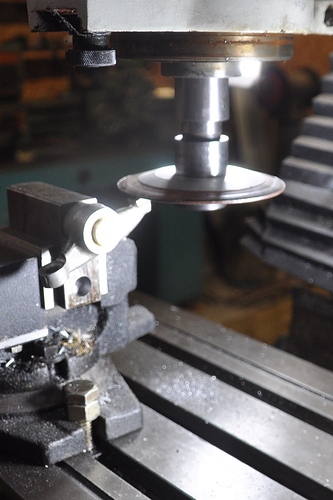Hi Guys
I dismantled my rocker assembly to find that each rocker had a one piece bush effectively shutting off the oil supply to the push rods. despite this the cam followers were well oiled and from the markings were turning correctly. Ed at various times has been quite passionate about the necessity of plenty of oil flowing down the pushrods so whilst the engine was down, to turn up some new short bushes. However as can be seen in the photo, the oil drillings are not central at the rocker positions and would be covered over by the new bushes. Have others come across this situation?
Regards
Mike
Hi Mike.
It is correct original rocker shaft drillings were offset and behind one bushing.
There was in fact a .003" machined face on the shaft directing oil into the middle of the two bushes supplying oil to both ends of the rocker. Once it wears this machining disappears.
Replacement shafts I found have the drilling re-positioned in the middle and can supply too much oil to the rockers and in my case, with worn valve guides, created smoking.
Regards, Graham
sorry. Only now noticed you mention a single bushing.
Do the have a hole drilled right through them?
Cheers. G
The original rockers had 2 bushes with a gap between them
I think Ian Mullins had a batch of these done.
The system also supplies oil [ an amount limited by the felt wick] to the valve stems.
My bushes dont have any holes - cant remember now as it is 35 years since they were fitted but I may have machined them myself. So what to do now? I could leave things alone as they have been proved over the years and are showing no wear. The alternative is to grind a small flat across each hole and then make up a set of half bushes.
If you have oil running down each push rod and you are happy with your oil pressure then I don’t think you need to take any further action.
Peter
I cant advise on that one. I’m sure there would be obvious signs of wear if it wasn’t getting enough oil so sounds like not an issue.
I am just doing a set of rockers at the moment. I found most of the drilling through the rockers, front and rear, were blocked. As a consequence I found a lot of wear on the face of the rockers on at the valve end.
Regards, Graham
Well, because I have been running one piece rocker bushes with no holes means that I was not getting oil coming out of either end of the rocker and yet the cam followers were well lubricated from I take it residual spray from within the engine. In fact I could find nothing amiss throughout the valve gear. This leads me to think that - dare I say it and let me take cover from all the brick throwing - that there is some over engineering. Admittedly my car rarely sees in excess of 3000rpm although I do sometimes sit on the speed limit for a 100km or more. Anyway, it has been working fine for 35 years so I think I will let sleeping dogs sleep. I had very deep wear on my rocker pads as well when doing the engine 35 years ago and remedied the problem by facing the pads with stellite. They have worn very well with just a polished witness mark except for just one which for some reason has rutted.
Regards
Mike
Stellite would have been hard [ as in difficult hard] to drill the holes in the rocker face.
Yes it may be very difficult even with a 1/16" solid carbide drill. In the first photo it shows how the stellite has withstood wear for 35 years of running and shows just a polished witness mark with no rutting. All rockers were similar apart from one which showed wear and I suspect a thin stellite layer. In reality I could have used the rockers with no further attention but decided to reface the pad as shown in the short video.
I used a 4" diam diamond wheel with 180 grit - a bit too coarse and 320 grit would have been better at full mill speed of 1250rpm. These diamond wheels are quite cheap on eBay. This setup creates the correct pad radius so that the rocker rolls across the valve stem with no sliding. The stellite covered the oil hole which I made no attempt to recreate. I tried to upload a 10 second video but failed but the rocker is pressed against the wheel whilst pumping the spindle up and down to create the curvature.
Regards Mike
How did you do that?
35 years ago I could buy from the then CIG (Commonwealth Industrial Gases) Stellite as 1/16" diam wire and it was put on with the oxy - quite a simple process actually. I tried to find some recently but could find either 5kg package at approx $1000 or to buy it as a MIG welder roll also at greater cost than I wanted to pay. Some welding places will do it for you but would have to hunt around as per cost. If you can find it as wire it fuses readily under a reducing flame. If anyone locates a supply please let me know as I would like to have a couple of sticks for the shed.

